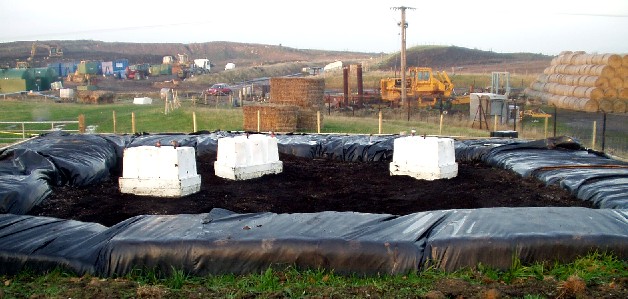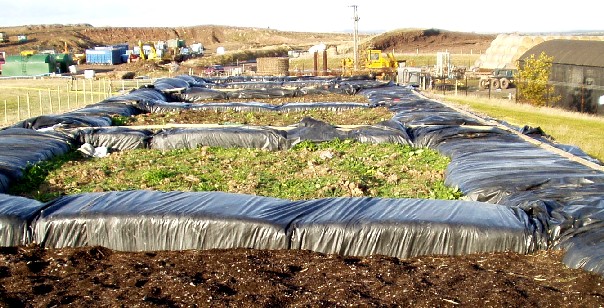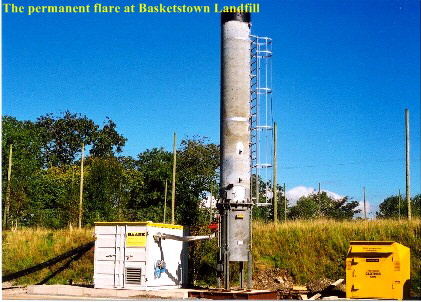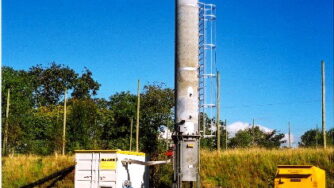In this article we discuss landfill gas bio-oxidation (also referred to by many people as the development of the landfill gas biofilter). We also suggest practical methods for avoiding greenhouse gas emissions at closed landfills. This is generally LFG from landfilled waste which is usually 15 years old or older.
As time passes, both the rate of landfill gas being produced in a landfill site and the proportion of methane in it declines and eventually reaches a point where burning the gas in a flare becomes unreliable.
Ultimately a point is reached where combustion cannot be sustained without the use of a support fuel such as propane. As well as incurring substantial costs for the landfill operator, the environmental acceptability of consuming fossil fuels in this way is questionable.
It is also worth pointing out that once there is no longer a revenue stream from the sale of the gas through the production of Energy from Waste from the site, the maintenance of active gas flaring equipment becomes a costly burden on the landfill owner.
However, there is a possible alternative to active gas flaring at many closed landfill sites which we describe in the sections which follow.
The Landfill Gas Bio-oxidation Alternative to Active LFG Extraction Using Landfill Gas Biofilter Technology
Combustion is not the only method of destroying methane. It can also be oxidised through microbiological activity. The practical application of microbiological processes to convert the methane in extracted landfill gas to carbon dioxide has shown promising results.

Research was done during the 1990s in the UK, and funded by the UK government to define the design parameters for a biofilter. One that can replace an otherwise conventional gas extraction system when the methane content of the gas becomes insufficient to support combustion reliably. This will enable operators to reduce greenhouse gas emissions from landfill gas extraction systems without incurring the penalties associated with the use of support fuels at sites where gas production is declining.
Background
Both the rate of gas generation and the proportion of methane in the gas from old landfills declines slowly after reaching a peak. The peak output from each cell various but that generally occurs a few years or two after emplacement of the waste. In addition to sites where the methane content of the gas is declining, there are many others where the methane concentration remained low throughout, because of the nature of the waste, or for example the ingress of air.
For many reasons a landfill may only produce a landfill gas quality which is marginal for reliable flaring, and as the proportion of methane in the gas reduces and that of air rises, there is a point where the methane content is too low to support combustion in a standard flare, at all.
The EU Landfill Directive requires that all landfill methane must be burnt, in the interests of reducing Greenhouse Gas emissions, even if a support fuel is needed. But even before this stage is reached, flaring becomes unreliable and operators experience increasing call out attendance in an effort to avoid environmental risks.
Biofiltration
Landfill gas bio-oxidation can be achieved by passive biofiltration using a biofilter.
Biofiltration in a biofilter is the use of micro-organisms, usually bacteria, to remove unwanted substances from a stream of mixed gases. The technique is widely used, particularly by the food processing industry where it is often necessary to remove odorous compounds before process gas is released to the atmosphere. Biofilters have a proven track record for removing volatile organic substances from process emissions and there is a growing body of evidence that they can also be used for methane removal by incorporating naturally occurring methane oxidising bacteria (methanotrophs).
There are two basic types of biofilter:
Soil-bed Biofilters
In these, the “dirty” gas is passed through a bed of organic “soil” such as compost, before being allowed to disperse to the atmosphere. Micro organisms living in the soil metabolise a range of undesirable compounds and so prevent their emissions to the air. Because soil will support a great diversity of micro organisms, soil-bed biofilters lend themselves to applications where the volume and composition of the gas varies and where a wide range of compounds need to be removed.
Soil-bed biofilters are simple and very robust. They require little maintenance but they occupy a relatively large area of ground.

Tower Biofilters
In these, a predetermined population of micro-organisms is established on an artificial substrate designed to present a very large surface area. In this way, the equivalent capacity of a soil-bed biofilter can be provided in a container small enough to be transported by road.
Tower biofilters are best suited to applications where a relatively small number of compounds need to be removed from the gas and where changes in flow rate and composition occur relatively slowly.Our research on two projects has concentrated upon the use of soil-bed biofilters.
Objectives of the landfill gas bio-oxidation research at Betton Abbotts Landfill
The research now in progress will concentrate on the construction and testing of a pilot scale soil-bed Biofiltration unit on a landfill site to determine the design parameters for full scale applications.
It involves the active participation of the landfill operator (SITA) who is making gas extraction facilities available at their Betton Abbots Landfill for the duration of the programme.It involves the construction, operation and monitoring of a series of pilot scale soil bed biofilters using different media. The trials are being conducted on a completed area of the site where landfill gas is already being pumped to a flare. This will provide a stable, measurable supply of landfill gas.
A proportion of the landfill gas will be diverted from the flare supply, and passed through the biofilters. To ensure safety, the quality of the inert gas will be adjusted by dilution with air so that it remains below the Lower Explosive Limit. The quality of the treated gas will be monitored. A variety of compost based soil materials will be tested.
The specific aspects that will be investigated include:
- Definition of bioactive soil media
- Effect of changes in gas quality and pumping rates to determine points where the system becomes overloaded
- Inhibition of the process through build up of contaminants and/or depletion of nutrients
- Tolerance to changes in temperature and moisture content due to weather.
The project was undertaken by Enviros and funded under the UK Landfill Tax Credit Scheme, with contributions from SITA Environmental trust, and direct funding from Clark Energy, and Pipeline Services Ltd.
The Performance of Passive Biofilter Landfill Gas Vents at Ballymacvea Landfill, Northern Ireland
It was estimated that for the UK during the 1990s, landfill methane accounted for about 40% of the UK's total greenhouse gas emissions.

About half of this was attributed to 400 or so large landfill sites accepting predominantly household, and commercial and industrial waste, with the balance accounted for by closed sites and operational sites taking small amounts of biodegradable waste.
The need to reduce greenhouse gas emissions has become almost an act of faith, and for UK landfill operators it has also become a legal requirement through implementation of the EC Landfill Directive which requires landfill gas to be collected and burned, preferably with energy utilisation.
This is enforced through site licences and PPC permits.
Owners of earlier unlicensed, closed sites are under no such legal obligation and few have active gas extraction systems. Yet closed sites are estimated to account for about 25% of the total landfill methane emissions.
It would therefore seem logical that landfill gas oxidation which is essential to reduce the high greenhouse gas impact of methane emissions, should be installed at all closed landfill sites if this can be done in some way, however to be affordable it would need to be done at a much lower cost than methane oxidation by combustion.
Research undertaken by Enviros at the Ballymacvea landfill site in Northern Ireland in the 1990s suggested that an effective alternative is possible.
In 1999, about 2 hectares of Ballymacvea landfill site, filled predominately with household waste, was completed and capped with clay. No gas venting or extraction was provided. Thirty gas monitoring standpipes were installed through the capping in three test areas at 10, 20 and 30 m spacings. The standpipes just penetrated into the underlying waste. Weekly gas monitoring was carried out to assess the establishment of methanogenic conditions in the waste throughout each of the test areas.
The gradual disappearance of oxygen and methane and carbon dioxide compositions attaining concentrations of 60%v/v and 40%v/v respectively, confirmed methanogenic conditions. This was reached in many of the standpipe locations in as little as 3 or 4 weeks from the capping being installed. However, a few of the standpipes still contained detectable oxygen after a year.
Following establishment of methanogenic conditions in the waste, twenty-three passive vents were installed in the test cells, about two metre from the standpipes.
Each vent comprised 1 metre diameter concrete rings, stacked and set into holes cut through the capping, resting on the exposed surface of the waste and protruding about 0.5 metres above ground level. Each was filled to ground level leaving a headspace to be used as a flux chamber. The material used for filling ranged from good quality green-waste compost, through a range of compost/soil/inert mixtures. In addition, one vent was filled with the excavated capping material and another with fines free, crushed basalt.
Fluxes of methane from the vents were been monitored at monthly intervals using, with slight adaptations, the Landfill Methane Measurement Protocol published by the Environment Agency.
The results were very encouraging. Fluxes of methane from many of the vents were very small confirming the ability for soil micro-organisms to act as a landfill gas biofilter and bio-oxidise methane. Laboratory and theoretical studies suggest that methane bio-oxidation may well be able to cope with the rates of generation encountered at many landfill sites, though so far as the author is aware, this was the first time that the theoretical and laboratory research has been put to test under full-scale landfill conditions.
The Ballymacvea landfill site was at the time an operational site and the area used for the investigation was close to its peak in methane generating capacity. Even so the results indicate that the media in some of the vents had the capacity to oxidise the methane and flammable trace gases to a level where they become undetectable using a flame ionisation detector capable of 0.1 part per million resolution.
Most old landfills as well as recent ones that contain a low proportion of degradable wastes, will have a much lower rate of landfill gas generation than Ballymacvea. With the lower methane production rates at these sites it should be possible to assure the level of performance achieved by the most effective of the vents at Ballymacvea.
Therefore it was concluded that passive landfill gas biofilter vents may offer an effective means of reducing greenhouse gas emissions from many landfill sites. This will be especially relevant where the statutory requirement to collect and burn the gas does not apply, or where “Landfill Gas Production Rate Quick Calculation Method” rates of methane production are not sufficient to maintain combustion without the need for costly support gases.
A full scientific paper on this project was published in the Proceedings of the International Landfill Symposium, Sardinia, 2003. Contact us via our contact form if you seek more information from us, or have a landfill gas biofilter project you wish to discuss.
Conclusion Landfill Gas Bio-oxidation Using Biofilteration
Biological oxidation is the reduction of methane to carbon dioxide and water. This can be achieved in a biofilter, through the normal metabolic process of micro-organisms, and is an emergent technology still under development.
Passive Landfill Gas Biofilter Research Reveals Potential as an Effective and Viable Option
The Landfill Gas Biofilter – Developing Bio-oxidation Filter Technology for Landfill Gas Treatment During the Long Period of Dwindling Gas Yields at Modern Sanitary Landfills (This article is based upon a paper ref: M. Huber-Humer; Dwindling Landfill Gas – Relevance and Aftercare Approaches; 2nd Boku Waste Conference 2007, Institute of Waste Management, BOKU.) The production and […]




